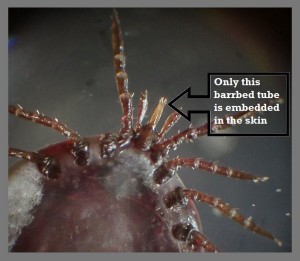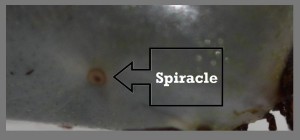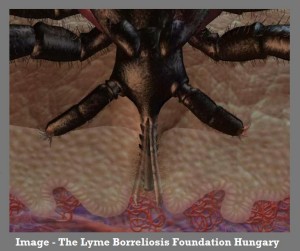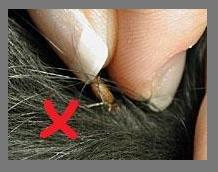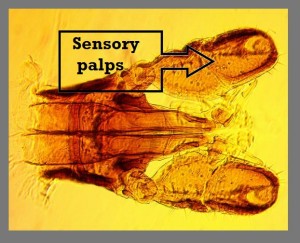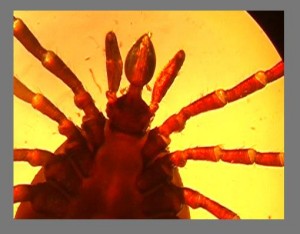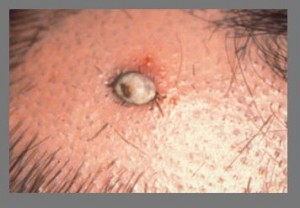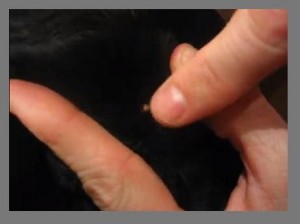How a tick is removed is extremely important. Incorrect removal can result in:
- The tick’s mouth parts being left behind in the skin.
- Compression of the tick’s body.
- Puncture of the tick’s body.
- Injury and irritation to the tick.
Why is this a problem?
- Leaving behind the tick’s mouth parts may result in a localised infection, which in severe cases can lead to abscesses and even septicaemia.
- Compressing the tick’s body may cause fluids (its saliva and gut contents) to be squeezed back into the bloodstream of its host (the person or animal it’s attached to). These fluids may contain disease-causing organisms.
- Puncturing the body of the tick may spill infective fluids (full of disease-causing organisms) on to the host, or on to the person removing the tick.
- Causing injury or irritation to the tick may result in it regurgitating (vomiting) infective fluids into the host, potentially causing a serious infection.
Use the above links to find out the correct technique for tick removal with tweezers and a tick-removal tool, and check out our MYTH BUSTING section below.
MYTH BUSTING
Through the Internet and common folklore, misinformation about tick removal perpetuates, some of which may significantly increase the risk of an infection resulting. Below we bust the top myths about tick removal that we hear on a regular basis.
MYTH 1 – If you’re not careful you’ll leave the tick’s head in!
MYTH 2 – If you don’t remove a tick correctly, you’ll leave the legs in!
MYTH 3 – Ticks can be suffocated so they drop off on their own!
MYTH 4 – If you burn or freeze off a tick it won’t leave its head in!
MYTH 5 – You turn the tick clockwise / anti-clockwise and it will come off more easily!
MYTH 6 – Taking off a tick with your fingers / finger nails is the best method of tick removal!
MYTH 7 – You can see if a tick’s head has broken off by checking it after removal!
MYTH 8 – If the bite area is dry, the tick hasn’t regurgitated!
MYTH 9 – If an attached tick hasn’t fed, it’s safe!
MYTH 10 – If you don’t get a tick out quickly it will burrow right into the body!
MYTH 11 – If you leave a tick’s head in it will grow a new body!
MYTH 12 – If you surprise a tick it won’t grip on!
MYTH 13 – If you twiddle a tick in a circular motion it lets go!
MYTH 14 – If you leave a tick in, it will lay eggs inside you!
MYTH 1 – If you’re not careful you’ll leave the tick’s head in!
Incorrect. Ticks don’t have heads. What you can see is the ‘Capitulum’ (comprising the sensory palps and mouth parts), which is directly attached to their body. Only tiny cutting limbs and a barbed feeding tube (too small to see with the naked eye) enter the skin. However, the tick creates a pit in the flesh of its host, in which its body sits. This can make it appear as if the tick has gone deep inside the skin. See our tick ‘Feeding‘ section for more information.
Back to: MYTH BUSTING
MYTH 2 – If you don’t remove a tick correctly, you’ll leave the legs in!
Incorrect. As a tick swells with blood, its body gets fatter and its legs and mouth parts become hidden by its fat body. Only its mouth parts are inserted into the skin to draw up blood.
Back to: MYTH BUSTING
MYTH 3 – Ticks can be suffocated so they drop off on their own
Incorrect. A tick breathes through openings in its sides called ‘spiracles’. It only breathes around 1 – 15 times per hour. Using solutions such as alcohol, aftershave, oils / butter, paraffin, petroleum jelly or nail polish, to try to suffocate a tick, may cause it to regurgitate (vomit) saliva and gut contents as it tries to disengage its mouth parts and escape the irritating solution. Whilst this method may cause the tick to drop off, it may also increase the risk of disease-causing organisms entering the bloodstream of the person or animal the tick is attached to.
Back to: MYTH BUSTING
MYTH 4 – If you burn or freeze off a tick it won’t leave its head in!
Incorrect. Ticks don’t have heads (as above) and heating a tick (with a cigarette end, hot match, or cigarette lighter) or freezing a tick (with a freezing spray or ice) may cause the fluids inside it (saliva and gut contents) to be forced out into the bloodstream of the person or animal it is attached to. These fluids may contain disease-causing organisms. These methods can also cause injury to the person or animal the tick is attached to, and damage the body of the tick, which may cause fluids to spill, or the mouth parts to break away. Whilst the tick might drop off using these methods, a serious infection or injury may also result.
Back to: MYTH BUSTING
MYTH 5 – You turn the tick clockwise / anti-clockwise and it will come off more easily!
Incorrect. Ticks are not screw threaded. The barbs on the mouth parts can be released by a turning action but this should only be performed with a tool designed for twisting (e.g. The O’Tom Tick Twister). Twisting with tweezers, forceps or fingers is likely to exert too much pressure to the mouth parts and they may break off.
Back to: MYTH BUSTING
MYTH 6 – Taking off a tick with your fingers / finger nails is the best method of removal!
Incorrect. Using fingers for tick removal is likely to compress the body of the tick, forcing fluids (saliva and gut contents) into the bloodstream of the person or animal it is attached to. If these fluids contain disease-causing organisms, this increases the likelihood of a serious infection resulting. Using fingernails to nip a tick off, even if you have avoided compressing the tick’s body, is likely to exert pressure to the mouth parts and snap them off. A tick should not be handled with bare hands as certain disease-causing organisms can enter through breaks in the skin or muscous membranes (if you touch your eyes, nose or mouth). Use the links above for the correct technique using tweezers or a tick-removal tool.
Back to: MYTH BUSTING
MYTH 7 – You can see if a tick’s head has broken off by checking it after removal!
Incorrect. As above, ticks do not have heads. What you can see is the Capitulum (the area comprising the sensory palps and tiny mouth parts). The palps are tactile limbs which are used to locate the best feeding spot and help to position the mouth parts. The palps do not enter the flesh of the host during feeding but remain spread apart on the surface. The mouth parts which enter the skin are the cutting limbs (chelicerae) and the barbed hypostome, which has a groove along it to draw up the blood. In order to examine the mouth parts of a tick, high magnification is needed.
Back to: MYTH BUSTING
MYTH 8 – If the bite area is dry, the tick hasn’t regurgitated!
Incorrect. It is impossible to tell whether a tick has regurgitated (vomited) as the mouth parts are deep in the flesh of the host. If the bite area is wet after tick removal, it is likely that the body of the tick has ruptured during the process of removal.
Back to: MYTH BUSTING
MYTH 9 – If an attached tick hasn’t fed, it’s safe!
Incorrect. It is possible for back-flow of fluids from a tick to occur during removal even if the tick is in an unfed state. Although the tick goes through a physiological process before certain disease-causing organism migrate from the gut of the tick to the salivary glands, research demonstrates that ticks can already have gone through this process and have been dislodged before re-attaching to another host. It also depends on the type of disease-causing organism as to how soon transmission occurs. Whilst the risk from un-engorged ticks (unfed or partially fed) is lower, it is possible for transmission of disease to occur at any stage of tick attachment.
Back to: MYTH BUSTING
MYTH 10 – If you don’t get a tick out quickly, it will burrow right into the body!
Incorrect. As above, only the mouth parts of a tick enter into the body. The tick can appear to sink deeply into the flesh of its host because it creates a pit for blood to flow into before the tick draws it up into its body. No matter how long a tick is attached, it will never disappear inside the body. However, the longer a tick is allowed to feed, the higher the risk is of a disease resulting.
Back to: MYTH BUSTING
MYTH 11 – If you leave a tick’s head in it will grow a new body!
Incorrect. As previously, only a tick’s mouth parts enter the body of its host. If the mouth parts break off, they become dead matter and cannot regrow.
Back to: MYTH BUSTING
MYTH 12 – If you surprise a tick it won’t grip on!
Incorrect. Ticks have back-facing barbs on their mouth parts and most hard-tick species cement themselves into the skin with special saliva. It takes some time for a tick to engage its mouth parts in the skin and for it to disengage them. You cannot surprise a tick!
Back to: MYTH BUSTING
MYTH 13 – If you twiddle a tick in a circular motion it lets go!
Incorrect. Twiddling / rotating a tick will not make it dizzy or make it release its grip. The tick will come away eventually but this results from the rotating action weakening the mouth parts and snapping them off. The mouth parts will then remain in the host and this could lead to irritation, scarring and localised infection. Additionally, putting pressure on the tick can induce back-flow of fluids from the tick which may contain disease-causing organisms, increasing the risk of a serious infection.
Back to: MYTH BUSTING
MYTH 14 – If you leave a tick in, it will lay eggs inside you!
Incorrect. Ticks do not lay eggs either inside or on a host. Eggs are laid on the ground in soil and leaf litter, or around the nesting / roosting areas of their hosts. Some types of mites and lice do lay eggs on their host and confusion between ticks, mites and lice may have given rise to this myth.
Sometimes a tick bite (or insect bite) can become infected and the pus globules resulting from the infection can also be mistaken for eggs.
The best way to avoid contracting a tick-borne disease is to avoid tick attachment in the first place. For simple preventative measures, see our Top Ten Tips. To keep pets safe, see our Tick Prevention page.
Back to: MYTH BUSTING

